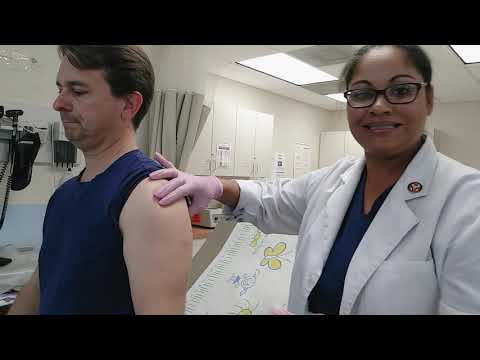Medical Assistants: Know Your Injection Sites
Contents
- Introduction
- What are the different types of injections?
- How do I know where to inject?
- What are the different injection sites?
- How do I choose the right injection site?
- How do I prepare for an injection?
- How do I give an injection?
- What are the aftercare instructions for an injection?
- What are the risks and complications of injections?
- Conclusion
Medical assistants must know the various injection sites on the human body in order to properly administer medications. This blog post will provide you with a comprehensive guide to injection sites.
Checkout this video:
Introduction
There are many different types of injections that Medical assistants may be asked to administer, and it’s important to know the correct injection site for each. Below is a list of some common injections and their recommended injection sites.
-Intramuscular (IM) Injections: These injections are given into the muscle tissue, and the sites for these are the upper arm, buttocks, and thigh.
-Subcutaneous (SC) Injections: These injections are given into the fatty tissue just below the skin surface, and the sites for these are the upper arm, abdomen, and thigh.
-Intradermal (ID) Injections: These injections are given into the dermis (the layer of skin between the epidermis and subcutaneous layer), and the sites for these are the forearm and upper back.
What are the different types of injections?
When it comes to injections, there are different types of injections that a medical assistant may administer, including intramuscular (IM), subcutaneous (SubQ), and intradermal (ID) injections. It’s important to know the difference between these types of injections so that you can properly treat your patients.
Intramuscular (IM) Injections: An intramuscular injection is a type of shot that is given into the muscle. This type of injection is usually given in the upper arm, buttocks, or thigh.
Subcutaneous (SubQ) Injections: A subcutaneous injection is a type of shot that is given under the skin. This type of injection is usually given in the fat layer between the skin and the muscle.
Intradermal (ID) Injections: An intradermal injection is a type of shot that is given into the skin. This type of injection is usually given in the upper arm, thigh, or stomach.
How do I know where to inject?
There are many factors to consider when selecting an injection site. The most important is to ensure that the medication will be absorbed into the bloodstream. To do this, you need to choose a site that has a good supply of blood vessels. You also need to be sure that the site is clean and free of infection. In addition, you should avoid injecting into areas where there is a lot of fat or muscle tissue.
What are the different injection sites?
Medical Assistants are often responsible for administering injections, so it’s important to know the different injection sites. The most common injection sites are:
-Upper arm: The deltoid muscle in the upper arm is a good injection site because it is large and easy to find. To locate the deltoid muscle, imagine a line running from your armpit to the middle of your bicep. The deltoid muscle is the fleshy area on the outer edge of this line.
-Thigh: The vastus lateralis muscle in the thigh is another good injection site because it is also large and easy to find. To locate the vastus lateralis muscle, imagine a line running from your hip to your knee. The vastus lateralis muscle is on the outer edge of this line.
-Buttocks: The buttocks are a good injection site because they have a large amount of flesh and there are few nerves in this area. To inject into the buttocks, use the upper outer quadrant (the “upper” being closest to the back and the “outer” being closer to the hip).
-Abdomen: The abdomen is a good injection site because it has a large amount of flesh and there are few nerves in this area. To inject into the abdomen, use the lower outer quadrant (the “lower” being closest to the pubic bone and the “outer” being further from the belly button).
How do I choose the right injection site?
There are many factors to consider when choosing an injection site. You must consider the patient’s age, weight, and health status. You also must think about the medication you are injecti
How do I prepare for an injection?
You should always clean the injection site with alcohol before injecting. You may also want to massage the area to help loosen the muscle. This will make it easier for the needle to go in.
How do I give an injection?
When giving an injection, it is important to know the proper injection sites. The most common sites for injections are the arms, legs, and buttocks.
The arm is a good choice for small injections, such as those for vaccinations. To find the best spot, extend your arm and divide it into three sections with your fingers. The outer section is the area between your shoulder and your elbow. The middle section is between your elbow and your wrist. The inner section is between your wrist and your thumb.
The leg is also a good choice for small injections. To find the best spot, divide your leg into three sections with your fingers. The upper section is between your hip and your knee. The middle section is between your knee and your ankle. The lower section is between your ankle and your toes.
The buttocks are the best choice for large injections, such as those given intramuscularly or intravenously. To find the best spot, divide each buttock into four sections with your fingers. The outer upper section is the area above the hip bone. The outer lower section is the area below the hip bone but above the crease of the buttocks. The inner upper section is the area above the crease of the buttocks but below the waistline. And finally, the inner lower section isthe area belowthe waistline but abovethe top ofthe thigh
What are the aftercare instructions for an injection?
After receiving an injection, it is important to follow your healthcare provider’s aftercare instructions. To avoid infection, medical assistants should clean the injection site before and after the procedure. You may also be instructed to apply a bandage to the area. It is important to keep the injection site clean and dry until the skin heals. If you experience any pain, swelling, or redness at the injection site, you should contact your healthcare provider.
What are the risks and complications of injections?
As with any medical procedure, there are certain risks and complications associated with injections. One of the most common complications is infection. To help reduce the risk of infection, it is important to clean the injection site thoroughly with soap and water or an alcohol swab before injection. It is also important to make sure that the needle is sterile and the medication is not expired.
Other potential complications of injections include:
-Bleeding
-Bruising
-Tenderness
-Swelling
-Redness
-Pain
Conclusion
medical assistants must be aware of the different types of injection sites and how to properly care for them. With proper knowledge and training, medical assistants can help ensure that patients receive the best possible care.







